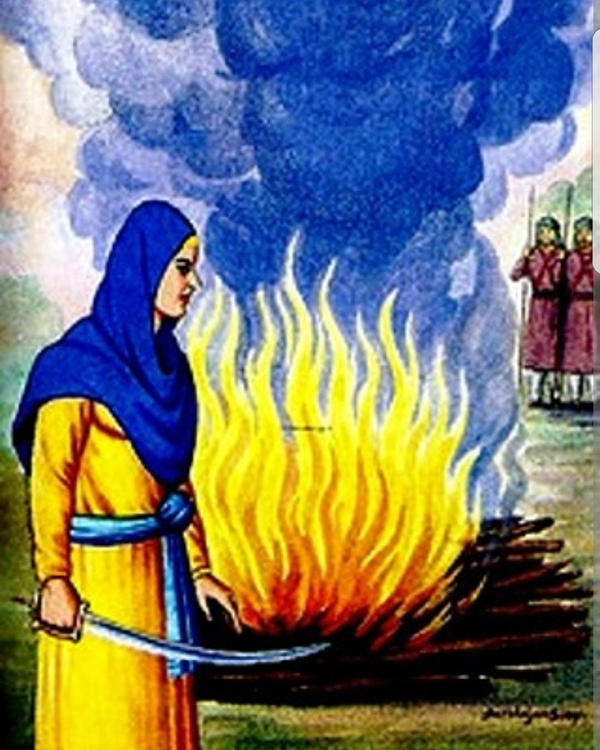
Bibi Harsarn Kaur
Sikh women are always known to have responded to the call of their duty. They have not allowed hardships and dangers to stand in the way of the performance of their moral obligations. Bibi Harsarn Kaur was one of these women who faced the odds to fulfill her obligations. Guru Gobind Singh’s two elder sons together with many other Sikhs, were martyred while fighting the foes at the battle of Chamkaur Sahib. Under pressure of supplications of the Sikhs, Guru Gobind Singh was obliged to leave the place under cover of darkness. The enemy too, taking advantage of the lull and darkness, rested in the surrounding area where they had besieged the Sikhs.
After leaving Chamkaur Sahib, Guru Ji reached the village where Bibi Harsarn Kaur lived. When he met her, she at once recognised the Guru. She bowed to Guru Ji and asked about the Sahib Jadey. She had been a nursing sister to them. Guru Ji told her about their martydom. She hurried to Chamkaur Sahib and stole on cat’s paw to the battle scene and recognised the martyred Sikhs. She collected all the wood she could and piled them high. She placed the bodies of the Sahib Jadey and the Sikhs on the pile and set it afire. The big conflagration woke the enemy with consternation. All their expectations of getting prizes and honours were dashed to the ground. Now there was nothing left to show their identities of their victims.
In the light of the fire, they were amazed to espy a female figure with a javelin in hand near the pile. They approached her and demanded to know who she was and whence she came. But nothing could make her speak. They became furious and threw Bibi Harsarn, javelin and all in the fire. Thus she too obtained martyrdom on 23rd Dec 1704.
Bibi Harsharn Kaur was a brave Sikh woman who gave her life to fulfill her obligation. She faced odds and did not allow dangers to stand in her way. She is well known for responding to the call of her duty ignoring her safety. Bhai Vir Singh in his book Kalghidhar Chamatkar Part V named her Sharan Kaur Guru Gobind Singh with his two elder sons, five beloved ones and thirty-five other Sikhs, forty-three souls in all reached Chamkaur, a village sixteen kilometers from the river Sirsa, which they crossed on 21st December 1704. Realizing that the enemy was in front and in the rear, they occupied a mud-built double-storied house there. The next morning they were besieged by thousands of Mogul soldiers. Two under aged princes, Ajit Singh, and Jujhar Singh (still in their teens), and thirty-five of the remaining Sikhs laid down their lives fighting bravely at the altar of faith and freedom before the night fall when the fight ended. The Guru himself took part in the battle, and killed, and wounded many.
Now the Guru was left with only five Sikhs who told the Guru that at that moment they were the Guru and he was the Khalsa. They ordered him to escape in the interest of the community. Three would accompany him and the remaining two would stay behind to continue the fight. Pressed by the repeated humble requests of the five Sikhs, the Guru was obliged to leave the place under the cover of darkness at midnight. Three Sikhs also left one by one. It was decided that they would meet in the garden near Machhiwara. Tired Moghul soldiers were also resting in darkness in the surrounding area. After leaving Chamkaur, the Guru reached a village where Harsharn Kaur, a baptized Sikh lady, lived. She recognized the Guru, bowed before him and asked about the princes and the other Sikhs. She had been a nursing sister to the princes. The Guru told her about their martyrdom. Hearing this, she made up her mind to cremate the dead bodies of the princes and other Sikhs. She realized that it was her moral duty to give these martyrs a decent cremation even if it cost her life.
She disguised herself as a Muslim woman, armed herself and secretly started for the battle scene. On reaching there, she saw that the Moghul soldiers were enjoying a sound sleep in their tents as they had been burying their dead soldiers throughout the day and were tired. She gathered all the dead bodies of the Sikh martyrs at one place. She collected sufficient dry wood and bushes, and piled them high. She placed all the dead bodies on the pile, prayed with tears in her eyes, and set them on fire. Flames of fire woke the sleeping soldiers. They ran to the scene and were disappointed to find that there was no dead body left. Now they could not show the identities of their victims and thus earn prizes and honors form their superiors.
In the light of the fire, they were surprised to find a woman. They asked her who she was and from whence she came. She did not speak, as she did not want to tell a lie. She stood without any sign of fear. They threatened her, but nothing could make her speak. When they saw that she had a sword in her hand, they became furious and one of them fired at her and injured her seriously. Now two soldiers lifted her and threw her body along with her sword in the fire. Thus she, too, obtained martyrdom on 23rd December 1704. Her soul met her martyred brothers. Her sacrifice is narrated many times.